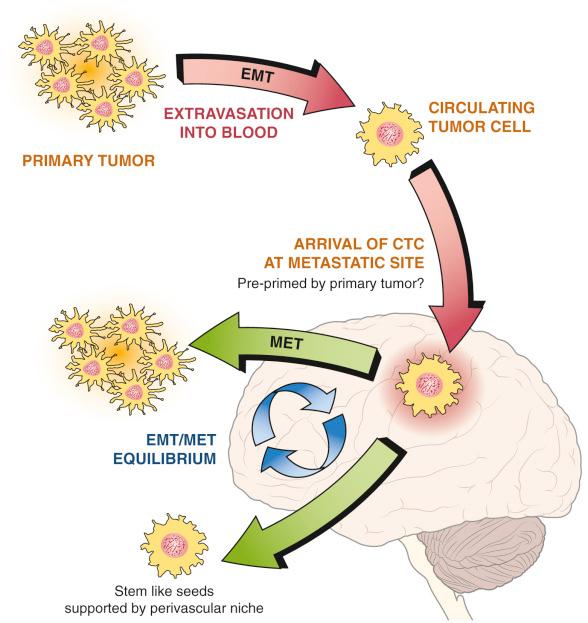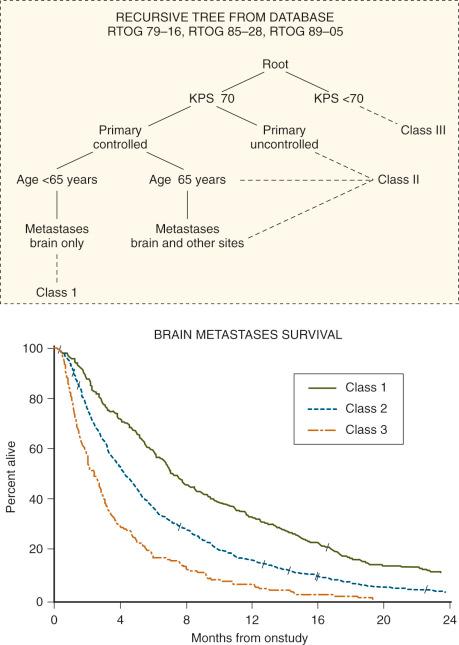Physical Address
304 North Cardinal St.
Dorchester Center, MA 02124
A metastatic brain tumor means that the patient has stage IV cancer, with median survival of less than 1 year.
When a patient presents with a new brain metastasis, without a known primary site, the chance of finding the primary tumor during the patient's lifetime is approximately 50%.
As long as brain metastases undergo some form of treatment, the majority of patients will succumb to progression of systemic disease as opposed to brain metastases.
Therapies for brain metastases are roughly equivalent, with a local recurrence rate of 40% to 50% at 1 year. Therefore, the choice of therapy must be tailored to the individual patient, taking into account Karnofsky Performance Scale score, medical comorbid conditions, systemic disease status, number of metastases, size and location of metastases, and symptoms.
It is essential that treatment decisions for this lethal disease be made by a multidisciplinary team of oncologists, radiation oncologists, and neurosurgeons, as well as the patient and the patient's family.
The incidence of brain metastases in the United States is about 10/100,000. The incidence of brain metastases is rising due to a combination of improved and earlier screening/detection as well as more efficacious systemic chemotherapies, which means cancer patients are surviving longer. Nearly 30% of patients with systemic solid cancers will develop cerebral metastases during their lifetime. This incidence was less than 5% in 1960. At presentation, 39% are single lesions, 54% one or two lesions, 72% fewer than four lesions. Neurosurgeons, radiation oncologists, and medical oncologists have been tasked with optimizing treatment paradigms for this heterogeneous patient population. The goals of this chapter are to present the previously published studies in a user-friendly fashion and to suggest treatment approaches and outcome expectations to assist in the management and counseling of these complex patients in neurosurgical practice.
The most common cancers to metastasize to the brain are lung, breast, melanoma, renal, and colorectal cancers ( Table 40.1 ). Lung cancer has the highest incidence, often with synchronous systemic and cerebral presentation, partly due to the high incidence of primary lung cancer in the general population. Melanoma has the highest propensity to spread to the brain, though usually with a metachronous presentation. Melanoma metastases, like breast cancer metastases, are thought to arise from other systemic metastases rather from than from the primary tumor itself. The risk of melanoma metastases in the brain increases when the primary is found in the head and neck region. Breast cancer metastases increase when HER2 is positive and estrogen and progesterone receptors are negative (HER2+, ER−, PR−).
| Primary Tumor Type | Total (%) | Single (%) | Multiple (%) | Time to Metastasis (mo) | Metastasis to Death (mo) |
|---|---|---|---|---|---|
| Lung | 40 | 48 | 52 | 3–6 | 4 |
| Breast | 17 | 49 | 51 | 40 | 4 |
| Melanoma | 11 | 49 | 51 | 31 | 5 |
| Renal cell | 6 | 56 | 44 | 28 | 6 |
| Gastrointestinal | 6 | 67 | 33 | 14 | 3 |
| Uterine/vulvar | 5 | 53 | 47 | 23 | 3 |
| Unknown | 5 | 70 | 30 | <1 | 7 |
| Ovarium | 2 | 57 | 43 | 23 | 8 |
| Bladder | 2 | 64 | 36 | 15 | 3 |
| Prostate | 2 | 82 | 18 | 22 | 3 |
| Testicular | 2 | 55 | 45 | 15 | 4 |
| Miscellaneous | 4 | 65 | 47 | 16 | 3 |
| Total | 100 | 53 | 47 | 12 | 4 |
Surgical resection of a brain metastasis has been extensively evaluated, but nonetheless its role remains controversial. Controversy stems not only from the relatively short median survival of these patients of about 10 to 12 months, but also the heterogeneity of the patient population, which makes the application of evidence-based medicine challenging.
The metastatic process is complicated. For solid tumors, this process begins with access to the bloodstream via intravasation. The blood-borne tumor cells must then traverse the microvasculature of the brain via extravasation, while avoiding immune surveillance. Once in the brain, the tumor cells undergo epithelial-mesenchymal transformation (EMT), avoiding anchorage-independent death. Once established in the brain, the cells must undergo reverse EMT (mesenchymal-epithelial transformation: MET), with conversion back to the parent cell phenotype and formation of a macrometastasis ( Fig. 40.1 ).

Brain metastases present with a wide variety of symptoms. More than two-thirds of patients are symptomatic at the time of presentation. Although headache is the most common presentation, tumor location determines the type and severity of deficits. Weakness and neurocognitive changes are common presentations.
Eighty percent of cerebral metastases are supratentorial and often located at the gray/white junction, although they are occasionally dural based and rarely located in other locations such as the pituitary gland or cerebral pontine angle. With contrast computed tomography (CT) or magnetic resonance imaging (MRI) studies, there is usually peripheral or heterogeneous enhancement. Brain metastases are typically associated with significant surrounding edema, often disproportionate to the size of the tumor. Renal and melanoma metastases are more often associated with intratumoral and peritumoral hemorrhages than other types of metastasis. The differential diagnosis for ring-enhancing cerebral lesions includes high-grade glioma, brain abscess, and subacute infarct. Advanced MRI can help differentiate among these. Evaluation of tumors with magnetic resonance spectroscopy (MRS) shows elevated choline (CHO) and depressed creatine (CRE) and n-acetyl aspartate (NAA). High-grade gliomas often have areas of necrosis with elevated lactate and usually have lower levels of myoinositol. An MRS tumor spectrum (elevated CHO, low CRE and NAA) can be found adjacent to gliomas, due to the invasive nature of these tumors, whereas brain adjacent to metastases usually has a normal MRS spectrum. Differentiation between dural-based metastases and meningiomas can often be accomplished with MRS. Meningiomas have elevated amino acids (such as alanine, glutamine and glutamate), whereas metastases do not ( Table 40.2 ).
| Pathology | Cho/Cr | Cho/Cho | NAA/Cr | Other | Peritumoral Cho |
|---|---|---|---|---|---|
| Metastasis | High | High | Low | Lipid/lactate | Low |
| High-grade glioma | Very high | Very high | Very Low | Lipid/lactate | High |
| Low-grade glioma | High | High | Low | Lipid | Normal |
| Gliomatosis cerebri | Normal/high | Normal/high | Low | Myoinositol | Infiltrating |
| Embryonal tumors | Very high | Very high | Low | Myoinositol/glycine | Unknown |
| Meningioma | High | High | Low | Glutamine/glutamate/alanine | Normal |
| Radiation necrosis | Low | Low | Low | Lipid/lactate | Low |
Because brain metastases arise from different tumor types, it is difficult to impose a uniform prognostic system. Nevertheless, the most widely used system in the United States is from the recursive partitioning analysis (RPA) of the radiation therapy oncology group (RTOG) ( Fig. 40.2 ). This analysis used RTOG 79-16, RTOG 85-28, and RTOG 89-05 to evaluate 1276 patients (the construction group) and was corroborated prospectively with RTOG 91-04, consisting of 445 patients (the validation group). A number of other prognostic classifications have also been developed.

It is critical to bear in mind that if the brain is treated (with any therapy or combination of therapies), for 85% to 95% of patients, length of survival (LOS) is driven by systemic disease. However, if left untreated, over 60% will die from progression of brain disease. Hence, a brain metastasis is a harbinger of systemic progression. Therefore, a recent systemic restaging is imperative prior to therapeutic intervention of any type. Treatment of brain metastases involves surgery or radiotherapy (either whole brain or sterotactic radiotherapy).
Three randomized control trials (RCTs) have evaluated the role of upfront surgery followed by whole-brain radiotherapy (WBRT) (“combined group”) versus needle biopsy and WBRT alone. Patchell and colleagues found the combined group had significantly decreased local recurrence rates (20% vs 50%) and improved overall survival (40 weeks vs 15 weeks), as well as prolonged functional independence (38 weeks vs 8 weeks). Vecht and colleagues found similar results, which were most pronounced in patients with stable extracranial disease. Notably, patients with progressive extracranial disease have a median overall survival of 5 months and functional independence of only 2.5 months, irrespective of treatment arm. A third RCT by Mintz and colleagues failed to note a survival difference between the radiation and combined groups but has been criticized for having a higher proportion of patients with extensive systemic disease and a lower baseline Karnofsky performance scores (KPS) (inclusion criteria were ≥50). In support of this critique are the RPAs done by the RTOG that found patients with KPS <70 had worse outcomes, as did older patients (age >65) with KPS >70 but with uncontrolled systemic disease . Additionally, MRI was not mandatory in the Mintz study, and it is possible that patients with additional lesions, not detected by CT, may have been included in this study.
One randomized trial evaluated the role of surgery plus WBRT versus stereotactic radiosurgery (SRS) plus WBRT, but it was complicated by accrual difficulties and subsequent low statistical power. In this trial, the estimated median overall survival times for SRS + WBRT and surgery + WBRT were not statistically different at 6.2 and 2.8 months, respectively ( p = 0.20). Corresponding median failure-free survival times were also not statistically different at 3.1 and 1.7 months. Two months after starting treatment there were no significant differences in quality of life between the arms. No other level I data are available regarding the choice of surgery versus radiosurgery for a single brain metastasis.
Two retrospective studies have compared SRS against surgical resection + WBRT. These demonstrated equivalent survival times between the two treatment groups. However, a retrospective study by Bindal evaluated 62 patients in the surgical resection + WBRT group and 31 in a SRS + WBRT group. The median survival time in the surgery group was significantly longer than in the SRS group (16.4 months versus 7.5 months), and incidence of death from neurologic causes in the surgery group was lower when compared to the SRS group (19% versus 50%, respectively).
Become a Clinical Tree membership for Full access and enjoy Unlimited articles
If you are a member. Log in here